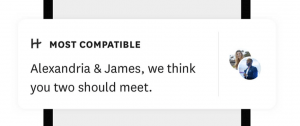Hinge: Dating Suggestions through Matching Algorithms
Hinge, a newcomer to the dating app game, introduced a new feature called “Most Compatible”, suggesting a single person that the app believes is a more suitable match for you compared to a random match. This concept is related to our class discussion of matching, as the application implements a form of the Gale Shapley algorithm for the “Stable Marriage Problem” on Bipartite Graphs (CMU), but instead of binary gender relationships, it is used on a single pool of users, no split gender divisions, and preferences ranked on user-inputted variables such as gender interest, proximity, age, ethnicity, religion, height, etc.
To analyze Hinge’s new feature and whether it works, we discuss the concept of a stable match– No pair (s,t) exists such that s is paired with t’ and t is paired with s’ such that s and t prefer each other over their partners (CMU). The Gale-Shapley algorithm run on a non-divided group requires selecting a “proposer”, analyzing their preferences, finding an available “receiver”, and matching if they are a good fit, adjusting if the “receiver” is already matched. This is related to finding socially optimal matchings which we discussed in class, as if we attribute a value for the preferences of proposers, we will be replacing temporary matches with a more optimal edge, and we will be finding a socially optimal matching (if we take it as the sum of the values of preferences for the proposers), at least for the proposers. Note that in this case, Hinge selects some users as “proposers” and some as “receivers”.
Consider the role of the “proposers” in this network. This network is unique in that any edge (s,t), s and t may value the match differently, i.e. s may prefer t over all others, but t prefers another s’ to s. In that case, s is “content” but t is not as “content”. Note that the connection is worth some v to s, and some v’ to t, two different values. Gale Shapley (the bipartite version) ensures that that the matching is stable, and that the proposers receive their optimal match, with no guarantee that the receivers receive their best match (CMU). Thus, this method of implementing Hinge’s “Most Compatible” feature is inherently slightly inequitable for those who are on the receiving end of the matching algorithm.
Despite the slight inequality in dating opportunity with their algorithm choice, I find Hinge’s new feature to be substantially better than competitors, as preference rankings use parameters inputted by the user (gender preference, proximity, age, religion….) to generate matches rather than Tinder, which seems to only use gender preference and proximity. I believe that Hinge has more informed and therefore better preferences with a higher probability of matching success, resulting in “more optimal” matches, but whether we should allow users to filter out potential matches based on our preferences (read: biases), is a question that our analysis of networks perhaps cannot answer.

